Acceptability Analysis of 3D-Printed Food in the Area of the Czech Republic Based on Survey
Abstract
1. Introduction
2. Materials and Methods
Statistical Analysis
3. Results and Discussion
3.1. Three-Dimensional Common Printing Awareness
3.2. Three-Dimensional Food Printing Awareness
3.3. Three-Dimensional Food Printing, Worries and Understanding
3.4. Three-Dimensional Food Printing, Application
3.5. Three-Dimensional Food Printing, Investments
4. Conclusions
Supplementary Materials
Author Contributions
Funding
Institutional Review Board Statement
Informed Consent Statement
Data Availability Statement
Conflicts of Interest
References
- Dankar, I.; Haddarah, A.; Omar, F.E.; Sepulcre, F.; Pujolà, M. 3D printing technology: The new era for food customization and elaboration. Trends Food Sci. Technol. 2018, 75, 231–242. [Google Scholar] [CrossRef]
- Jain, P.K.; Jain, P.K. Use of 3D printing for home applications: A new generation concept. Mater. Today Proc. 2021, 43, 605–607. [Google Scholar] [CrossRef]
- Singhal, S.; Rasane, P.; Kaur, S.; Garba, U.; Bankar, A.; Singh, J.; Gupta, N. 3D food printing: Paving way towards novel foods. An. Acad. Bras. Ciências 2020, 92. [Google Scholar] [CrossRef]
- Sun, J.; Peng, Z.; Zhou, W.; Fuh, J.Y.; Hong, G.S.; Chiu, A. A review on 3D printing for customized food fabrication. Procedia Manuf. 2015, 1, 308–319. [Google Scholar] [CrossRef]
- Gunjal, M.; Rasane, P.; Singh, J.; Kaur, S.; Kaur, J. Three-Dimensional (3D) Food Printing: Methods, Processing and Nutritional Aspects. In Food Printing: 3D Printing in Food Industry; Sandhu, K., Singh, S., Eds.; Springer: Singapore, 2022; pp. 65–80. [Google Scholar] [CrossRef]
- Kaur, J.; Bhadariya, V.; Singh, J.; Gupta, P.; Sharma, K.; Rasane, P. Materials for Food Printing. In Food Printing: 3D Printing in Food Industry; Sandhu, K., Singh, S., Eds.; Springer: Singapore, 2022; pp. 1–18. [Google Scholar] [CrossRef]
- Singh, J.; Kaur, J.; Rasane, P.; Kaur, S. 3D printed foods-carbs from the lab for better health. Curr. Opin. Clin. Nutr. Metab. Care 2022, 25, 271–276. [Google Scholar] [CrossRef]
- Berman, B. 3-D printing: The new industrial revolution. Bus. Horiz. 2012, 55, 155–162. [Google Scholar] [CrossRef]
- Cardello, A.V. Consumer concerns and expectations about novel food processing technologies: Effects on product liking☆. Appetite 2003, 40, 217–233. [Google Scholar] [CrossRef]
- Lee, K.H.; Hwang, K.H.; Kim, M.; Cho, M. 3D printed food attributes and their roles within the value-attitude-behavior model: Moderating effects of food neophobia and food technology neophobia. J. Hosp. Tour. Manag. 2021, 48, 46–54. [Google Scholar] [CrossRef]
- Tsimitri, P.; Michailidis, A.; Loizou, E.; Mantzouridou, F.T.; Gkatzionis, K.; Mugampoza, E.; Nastis, S.A. Novel Foods and Neophobia: Evidence from Greece, Cyprus, and Uganda. Resources 2021, 11, 2. [Google Scholar] [CrossRef]
- Demartini, E.; Gaviglio, A.; La Sala, P.; Mariantonietta, F. Impact of information and Food Technology Neophobia in consumers’ acceptance of shelf-life extension in packaged fresh fish fillets. Sustain. Prod. Consum. 2019, 17, 116–125. [Google Scholar] [CrossRef]
- Rabadán, A. Consumer Attitudes towards Technological Innovation in a Traditional Food Product: The Case of Wine. Foods 2021, 10, 1363. [Google Scholar] [CrossRef]
- Brunner, T.A.; Delley, M.; Denkel, C. Consumers’ attitudes and change of attitude toward 3D-printed food. Food Qual. Prefer. 2018, 68, 389–396. [Google Scholar] [CrossRef]
- Lupton, D.; Turner, B. ‘Both fascinating and disturbing’: Consumer responses to 3D food printing and implications for food activism. In Digital Food Activism; Schneider, T., Eli, K., Dolan, C., Ulijaszek, S., Eds.; Routledge: London, UK, 2016; pp. 151–167. [Google Scholar] [CrossRef]
- Manstan, T.; McSweeney, M.B. Consumers’ attitudes towards and acceptance of 3D printed foods in comparison with conventional food products. Int. J. Food Sci. Technol. 2020, 55, 323–331. [Google Scholar] [CrossRef]
- Caulier, S.; Doets, E.; Noort, M. An exploratory consumer study of 3D printed food perception in a real-life military setting. Food Qual. Prefer. 2020, 86, 104001. [Google Scholar] [CrossRef]
- Mantihal, S.; Prakash, S.; Bhandari, B. Texture-modified 3D printed dark chocolate: Sensory evaluation and consumer perception study. J. Texture Stud. 2019, 50, 386–399. [Google Scholar] [CrossRef] [PubMed]
- Pandey, A.; Sahu, R.; Dash, M.K. Social media marketing impact on the purchase intention of millennials. Int. J. Bus. Inf. Syst. 2018, 28, 147–162. [Google Scholar] [CrossRef]
- Vosner, H.B.; Bobek, S.; Kokol, P.; Krecic, M.J. Attitudes of active older Internet users towards online social networking. Comput. Hum. Behav. 2016, 55, 230–241. [Google Scholar] [CrossRef]
- Lupton, D.; Turner, B. “I can’t get past the fact that it is printed”: Consumer attitudes to 3D printed food. Food Cult. Soc. 2018, 21, 402–418. [Google Scholar] [CrossRef]
- Liu, C.; Ho, C.; Wang, J. The development of 3D food printer for printing fibrous meat materials. In Proceedings of the IOP Conference Series: Materials Science and Engineering, Philadelphia, PA, USA, 21–23 October 2017; IOP Publishing: Philadelphia, PA, USA, 2018; p. 012019. [Google Scholar] [CrossRef]
- Gómez-Donoso, C.; Sánchez-Villegas, A.; Martínez-González, M.A.; Gea, A.; Mendonça, R.D.D.; Lahortiga-Ramos, F.; Bes-Rastrollo, M. Ultra-processed food consumption and the incidence of depression in a Mediterranean cohort: The SUN Project. Eur. J. Nutr. 2020, 59, 1093–1103. [Google Scholar] [CrossRef] [PubMed]
- Romaguera, D.; Fernández-Barrés, S.; Gracia-Lavedán, E.; Vendrell, E.; Azpiri, M.; Ruiz-Moreno, E.; Martín, V.; Gómez-Acebo, I.; Obón, M.; Molinuevo, A.; et al. Consumption of ultra-processed foods and drinks and colorectal, breast, and prostate cancer. Clin. Nutr. 2021, 40, 1537–1545. [Google Scholar] [CrossRef] [PubMed]
- Ares, G.; Vidal, L.; Allegue, G.; Giménez, A.; Bandeira, E.; Moratorio, X.; Molina, V.; Curutchet, M.R. Consumers’ conceptualization of ultra-processed foods. Appetite 2016, 105, 611–617. [Google Scholar] [CrossRef]
- Boase, N.J.; White, M.P.; Gaze, W.H.; Redshaw, C.H. Why don’t the British eat locally harvested shellfish? The role of misconceptions and knowledge gaps. Appetite 2019, 143, 104352. [Google Scholar] [CrossRef]
- Freire, W.B.; Waters, W.F.; Rivas-Mariño, G.; Nguyen, T.; Rivas, P. A qualitative study of consumer perceptions and use of traffic light food labelling in Ecuador. Public Health Nutr. 2017, 20, 805–813. [Google Scholar] [CrossRef]
- Albertsen, L.; Wiedmann, K.P.; Schmidt, S. The impact of innovation-related perception on consumer acceptance of food innovations–development of an integrated framework of the consumer acceptance process. Food Qual. Prefer. 2020, 84, 103958. [Google Scholar] [CrossRef]
- Evans, G.; De Challemaison, B.; Cox, D.N. Consumers’ ratings of the natural and unnatural qualities of foods. Appetite 2010, 54, 557–563. [Google Scholar] [CrossRef]
- Baiano, A. 3D printed foods: A comprehensive review on technologies, nutritional value, safety, consumer attitude, regulatory framework, and economic and sustainability issues. Food Rev. Int. 2020, 38, 986–1016. [Google Scholar] [CrossRef]
- Portanguen, S.; Tournayre, P.; Sicard, J.; Astruc, T.; Mirade, P.S. Toward the design of functional foods and biobased products by 3D printing: A review. Trends Food Sci. Technol. 2019, 86, 188–198. [Google Scholar] [CrossRef]
- Lupton, D. ‘Download to delicious’: Promissory themes and sociotechnical imaginaries in coverage of 3D printed food in online news sources. Futures 2017, 93, 44–53. [Google Scholar] [CrossRef]
- Peng, T. Analysis of energy utilization in 3D printing processes. Procedia Cirp 2016, 40, 62–67. [Google Scholar] [CrossRef]
- Kellens, K.; Baumers, M.; Gutowski, T.G.; Flanagan, W.; Lifset, R.; Duflou, J.R. Environmental dimensions of additive manufacturing: Mapping application domains and their environmental implications. J. Ind. Ecol. 2017, 21, 49–68. [Google Scholar] [CrossRef]
- Bearth, A.; Siegrist, M. Are risk or benefit perceptions more important for public acceptance of innovative food technologies: A meta-analysis. Trends Food Sci. Technol. 2016, 49, 14–23. [Google Scholar] [CrossRef]
- Vidigal, M.C.; Minim, V.P.; Simiqueli, A.A.; Souza, P.H.; Balbino, D.F.; Minim, L.A. Food technology neophobia and consumer attitudes toward foods produced by new and conventional technologies: A case study in Brazil. LWT-Food Sci. Technol. 2015, 60, 832–840. [Google Scholar] [CrossRef]
- Barska, A. Attitudes of young consumers towards innovations on the food market. Management 2014, 18, 419–431. [Google Scholar] [CrossRef]
- Ryan, D.; Holmes, M.; Ensaff, H. Adolescents’ dietary behaviour: The interplay between home and school food environments. Appetite 2022, 175, 106056. [Google Scholar] [CrossRef]
- Dalma, A.; Kastorini, C.M.; Zota, D.; Veloudaki, A.; Petralias, A.; Yannakoulia, M.; Linos, A. Perceptions of parents and children, participating in a school-based feeding programme in disadvantaged areas in Greece: A qualitative study. Child Care Health Dev. 2016, 42, 267–277. [Google Scholar] [CrossRef] [PubMed]
- Hardcastle, S.J.; Blake, N. Influences underlying family food choices in mothers from an economically disadvantaged community. Eat. Behav. 2016, 20, 1–8. [Google Scholar] [CrossRef]
- Van der Heijden, A.; Te Molder, H.; Jager, G.; Mulder, B.C. Healthy eating beliefs and the meaning of food in populations with a low socioeconomic position: A scoping review. Appetite 2021, 161, 105135. [Google Scholar] [CrossRef]
- Dibsdall, L.A.; Lambert, N.; Frewer, L.J. Using interpretative phenomenology to understand the food-related experiences and beliefs of a select group of low-income UK women. J. Nutr. Educ. Behav. 2002, 34, 298–309. [Google Scholar] [CrossRef]
- Feng, X.; Khemacheevakul, K.; De León Siller, S.; Wolodko, J.; Wismer, W. Effect of Labelling and Information on Consumer Perception of Foods Presented as 3D Printed. Foods 2022, 11, 809. [Google Scholar] [CrossRef] [PubMed]
- Zhang, H.; Fang, M.; Yu, Y.; Liu, Q.; Hu, X.; Zhang, L.; Hu, H.; Zhang, C.; Huang, F.; Tian, F.; et al. Application Prospect of 3D Printing Technology in the Food Intelligent Manufacturing. In Proceedings of the Recent Developments in Mechatronics and Intelligent Robotics, International Conference on Mechatronics and Intelligent Robotics, Kunming, China, 19–20 May 2018; Springer: Cham, Switzerland, 2018; pp. 974–984. [Google Scholar] [CrossRef]
- Mantihal, S.; Kobun, R.; Lee, B.B. 3D food printing of as the new way of preparing food: A review. Int. J. Gastron. Food Sci. 2020, 22, 100260. [Google Scholar] [CrossRef]
- Chirico Scheele, S.; Hartmann, C.; Siegrist, M.; Binks, M.; Egan, P.F. Consumer Assessment of 3D-Printed Food Shape, Taste, and Fidelity Using Chocolate and Marzipan Materials. 3D Print. Addit. Manuf. 2021, 8, 1–32. [Google Scholar] [CrossRef]
- La Barbera, F.; Verneau, F.; Amato, M.; Grunert, K. Understanding Westerners’ disgust for the eating of insects: The role of food neophobia and implicit associations. Food Qual. Prefer. 2018, 64, 120–125. [Google Scholar] [CrossRef]
- Shelomi, M. Why we still don’t eat insects: Assessing entomophagy promotion through a diffusion of innovations framework. Trends Food Sci. Technol. 2015, 45, 311–318. [Google Scholar] [CrossRef]
- Egolf, A.; Siegrist, M.; Hartmann, C. How people’s food disgust sensitivity shapes their eating and food behaviour. Appetite 2018, 127, 28–36. [Google Scholar] [CrossRef] [PubMed]
- Jagadiswaran, B.; Alagarasan, V.; Palanivelu, P.; Theagarajan, R.; Moses, J.A.; Anandharamakrishnan, C. Valorization of food industry waste and by-products using 3D printing: A study on the development of value-added functional cookies. Future Foods 2021, 4, 100036. [Google Scholar] [CrossRef]
- Wang, L.; Zhang, M.; Bhandari, B.; Yang, C. Investigation on fish surimi gel as promising food material for 3D printing. J. Food Eng. 2018, 220, 101–108. [Google Scholar] [CrossRef]
- Roy, V.C.; Chamika, W.A.S.; Park, J.S.; Ho, T.C.; Khan, F.; Kim, Y.M.; Chun, B.S. Preparation of bio-functional surimi gel incorporation of fish oil and green tea extracts: Physico-chemical activities, in-vitro digestibility, and bacteriostatic properties. Food Control 2021, 130, 108402. [Google Scholar] [CrossRef]
- Pant, A.; Lee, A.Y.; Karyappa, R.; Lee, C.P.; An, J.; Hashimoto, M.; Tan, U.; Wong, G.; Chua, K.Z.; Zhang, Y. 3D food printing of fresh vegetables using food hydrocolloids for dysphagic patients. Food Hydrocoll. 2021, 114, 106546. [Google Scholar] [CrossRef]
- Le-Bail, A.; Maniglia, B.C.; Le-Bail, P. Recent advances and future perspective in additive manufacturing of foods based on 3D printing. Curr. Opin. Food Sci. 2020, 35, 54–64. [Google Scholar] [CrossRef]
- Wei, J.; Ma, X.; Zhao, S. Food messaging: Using edible medium for social messaging. In Proceedings of the SIGCHI Conference on Human Factors in Computing Systems, New York, NY, USA, 26 April 2014; Association for Computing Machinery: New York, NY, USA; pp. 2873–2882. [Google Scholar] [CrossRef]
- Jayaprakash, S.; Paasi, J.; Pennanen, K.; Flores Ituarte, I.; Lille, M.; Partanen, J.; Sozer, N. Techno-Economic Prospects and Desirability of 3D Food Printing: Perspectives of Industrial Experts, Researchers and Consumers. Foods 2020, 9, 1725. [Google Scholar] [CrossRef] [PubMed]
- Kocaman, Y.; Ermiş-Mert, A.; Özcan, O. Exploring Users Interested in 3D Food Printing and Their Attitudes: Case of the Employees of a Kitchen Appliance Company. Int. J. Hum.–Comput. Interact. 2022, 1–17. [Google Scholar] [CrossRef]

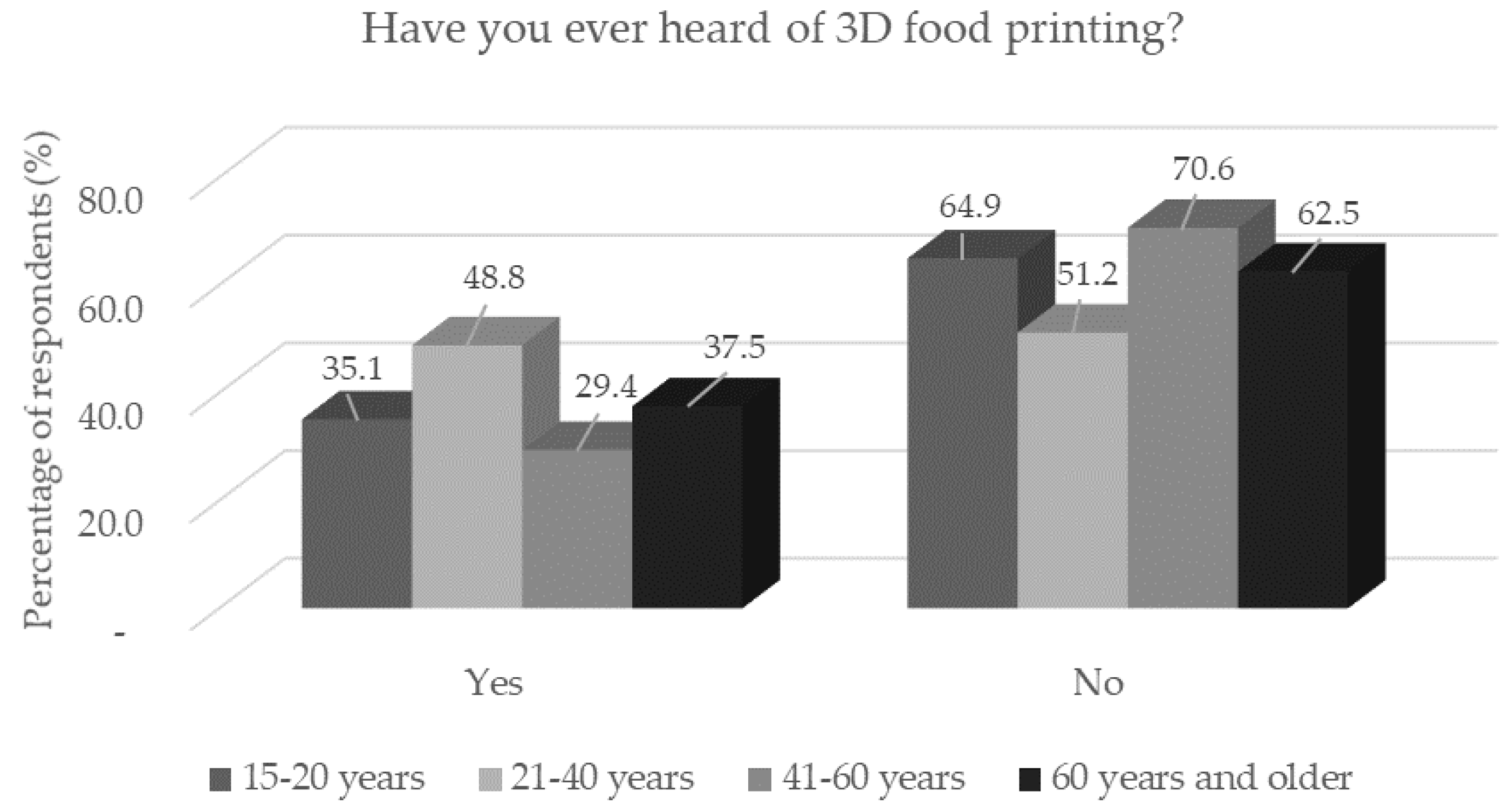
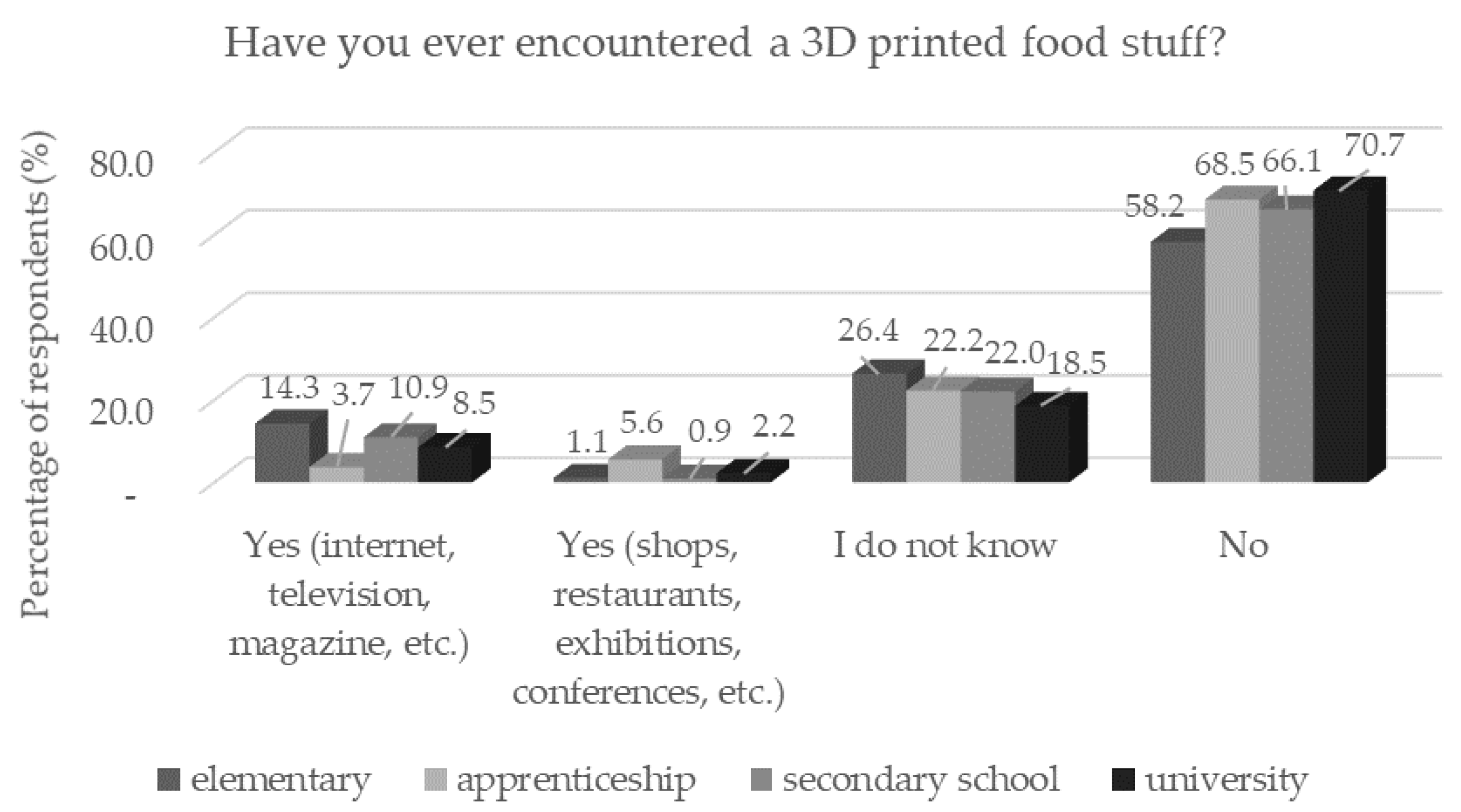

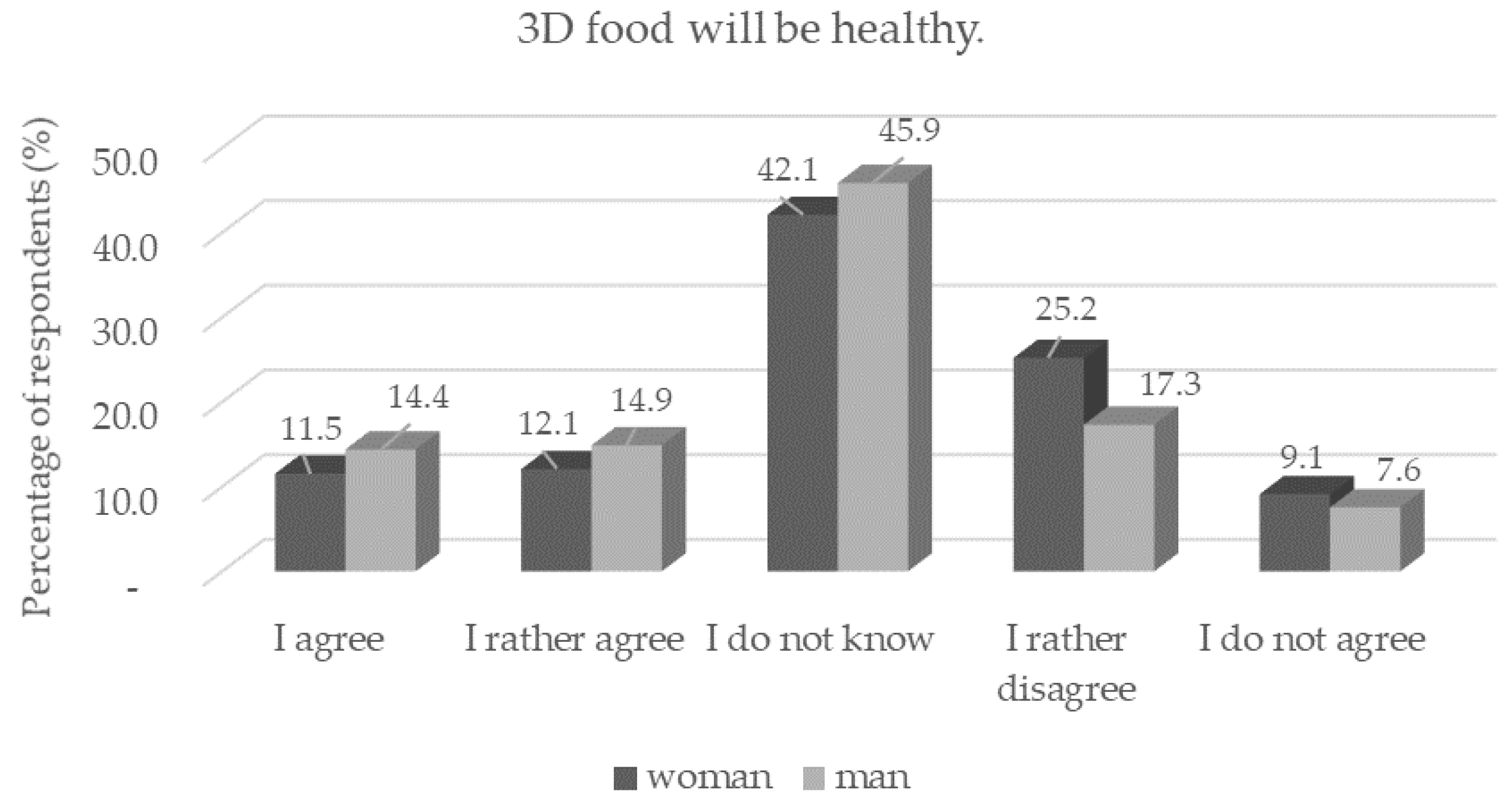
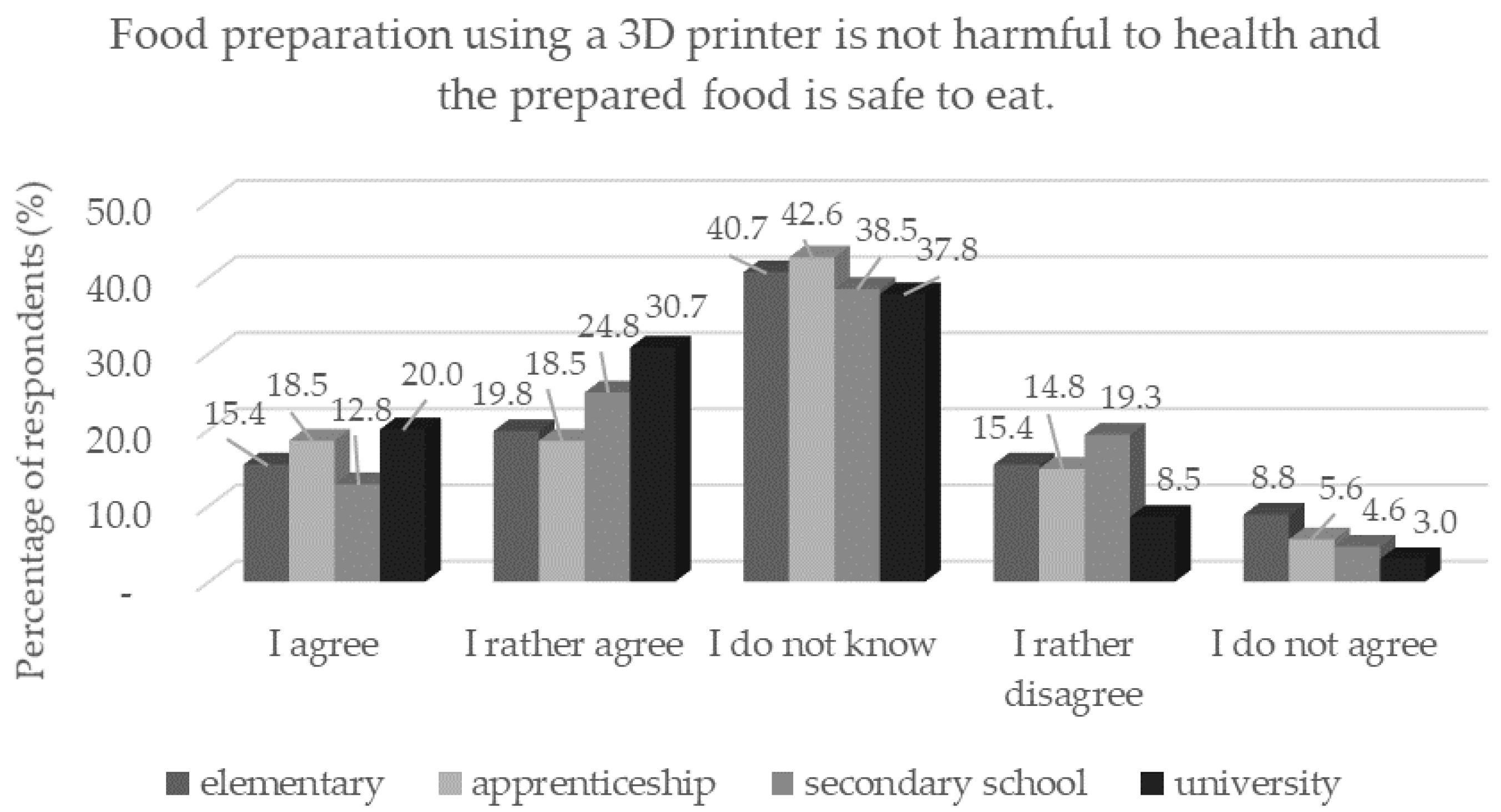

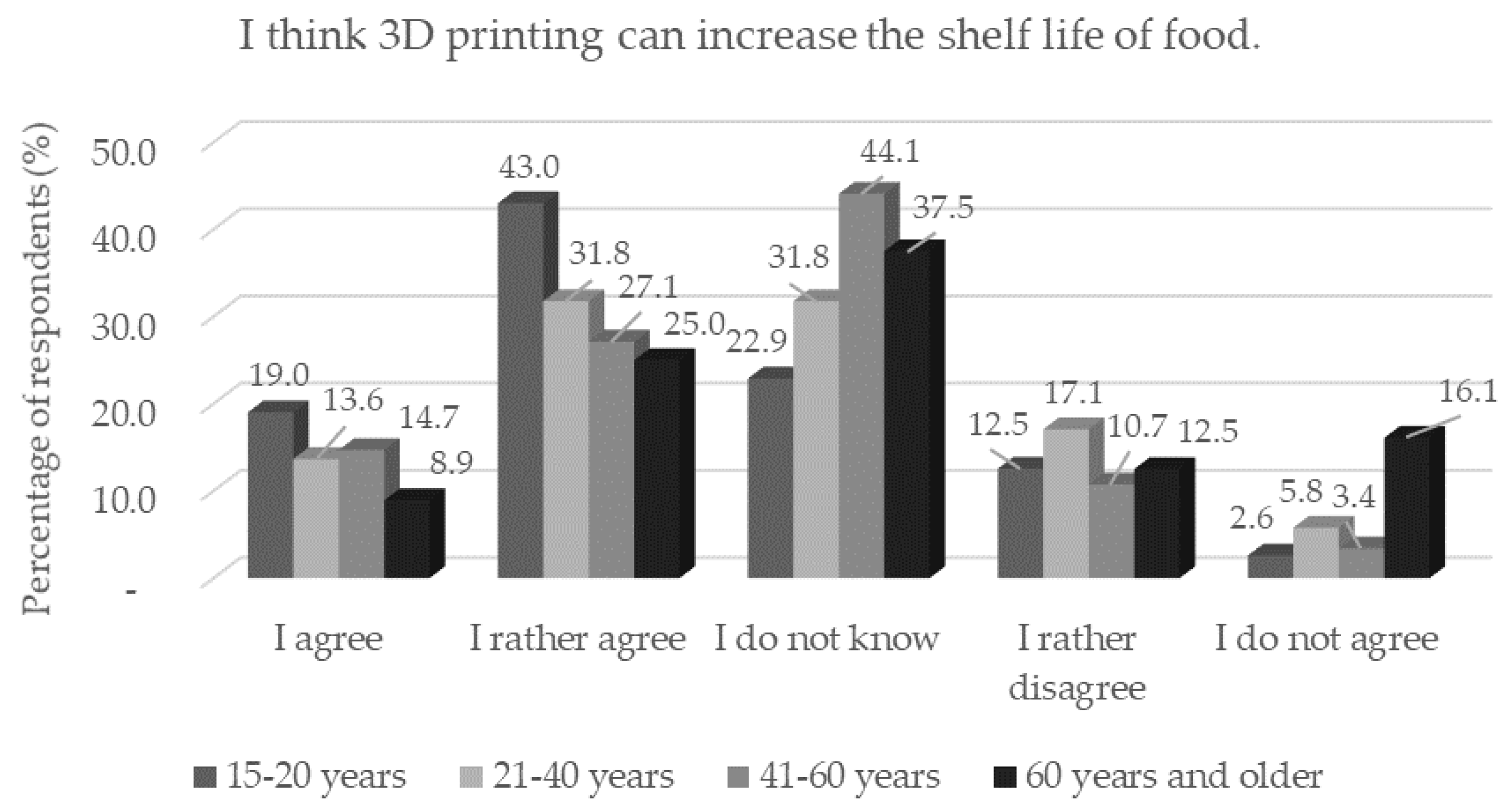

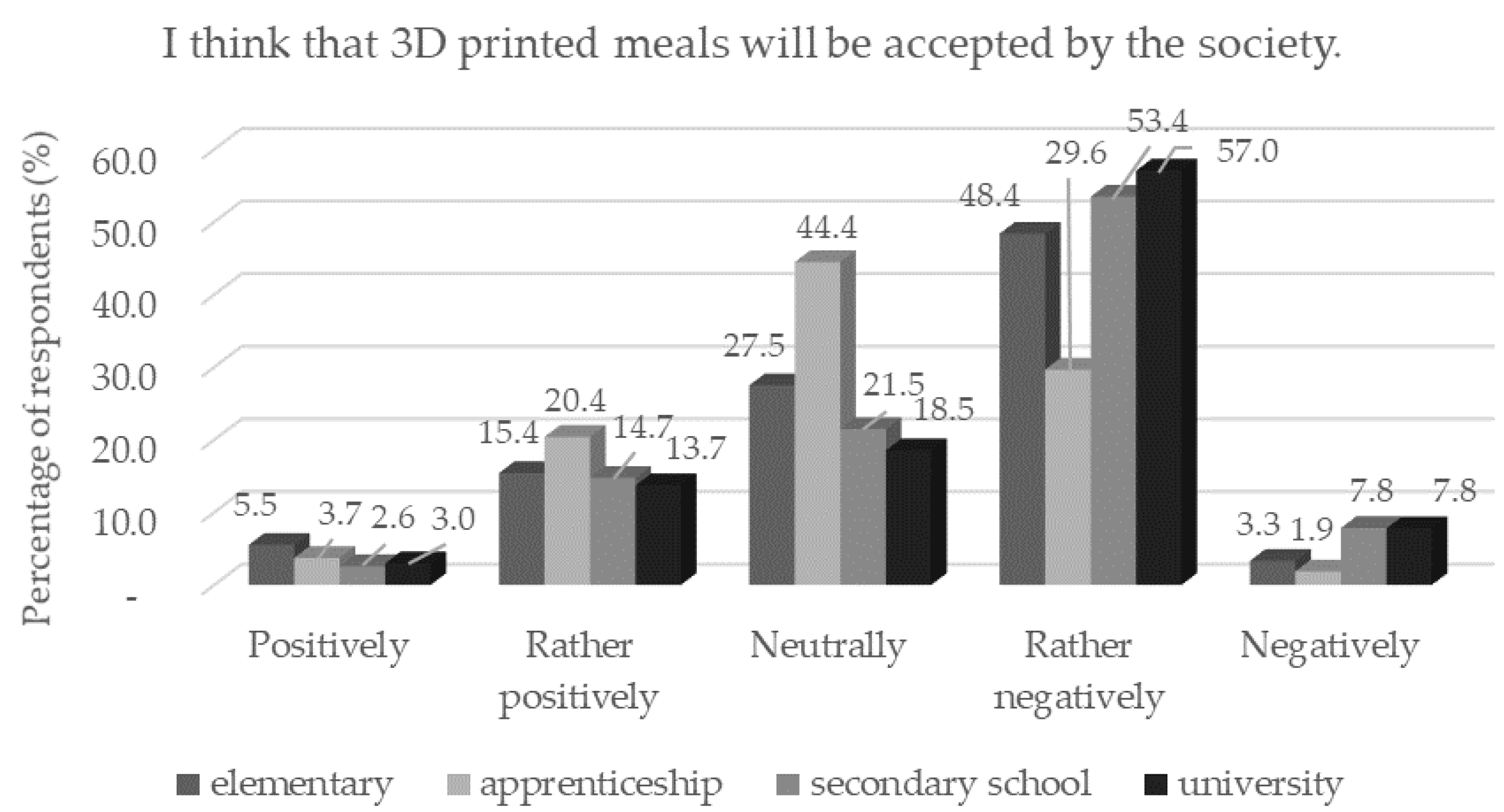
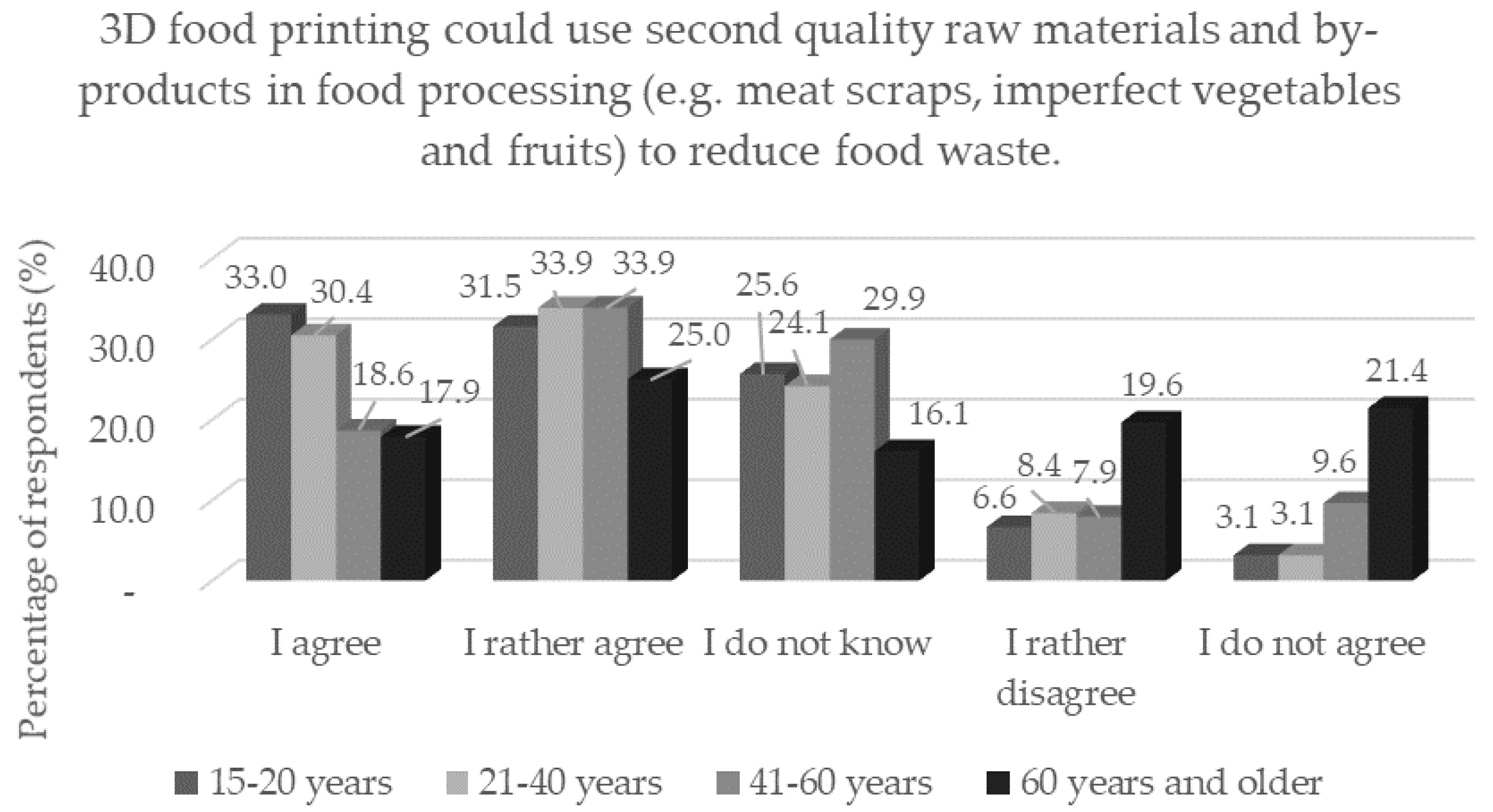


| SOCIODEMOGRAPHIC DATA | n 1 | %2 | |
|---|---|---|---|
| SEX | woman | 746 | 64.5 |
| man | 410 | 35.5 | |
| MARITAL STATUS | single | 911 | 78.8 |
| married | 245 | 21.2 | |
| AGE GROUP | 15–20 years | 542 | 46.9 |
| 21–40 years | 381 | 33.0 | |
| 41–60 years | 177 | 15.3 | |
| 60 years and older | 56 | 4.8 | |
| EDUCATION | elementary | 91 | 7.9 |
| apprenticeship | 54 | 4.7 | |
| secondary school | 741 | 64.1 | |
| university | 270 | 23.4 | |
| STATUS | student | 654 | 56.6 |
| civil servant | 142 | 12.3 | |
| private sector employee | 234 | 20.2 | |
| self-employed | 60 | 5.2 | |
| retired/disabled person | 46 | 4.0 | |
| unemployed | 20 | 1.7 | |
| GROSS INCOME GROUP | minimum income up to CZK 15,000 | 653 | 56.5 |
| average income up to CZK 35,000 | 369 | 31.9 | |
| above-average income over CZK 35,000 | 134 | 11.6 | |
| RESIDENCE | countryside | 432 | 37.4 |
| city/town | 724 | 62.6 | |
| SPECIAL DIET | none | 983 | 85.0 |
| food allergy/intolerance | 70 | 6.1 | |
| vegetarianism | 59 | 5.1 | |
| vegan | 13 | 1.1 | |
| other | 31 | 2.7 | |
| Distribution of Respondents (%) | ||||
|---|---|---|---|---|
| Yes | No | |||
| Have you ever heard of 3D printing? | 90.6 | 9.4 | ||
| Are you interested in 3D printing, e.g., by searching for references in the scientific or professional literature? | 19.5 | 80.5 | ||
| Have you ever heard of 3D food printing? | 38.8 | 61.2 | ||
| Have you ever encountered 3D-printed food stuff? | Yes (internet, television, magazine, etc.) | Yes (shops, restaurants, exhibitions, conferences, etc.) | I do not know | No |
| 10.3 | 1.5 | 21.5 | 66.7 | |
| Distribution of Respondents (%) | |||||
|---|---|---|---|---|---|
| I Agree/Yes | I Rather Agree/Rather Yes | I Do Not Know | I Rather Disagree/Rather Not | I Do Not Agree/Not | |
| Quality ingredients will be used to prepare the meals. | 29.8 | 22.6 | 29.0 | 14.4 | 4.2 |
| Three-dimensional food will be healthy. | 12.5 | 13.1 | 43.4 | 22.4 | 8.6 |
| I think that 3D-printed dishes are industrially ultra-processed foods. | 25.7 | 30.3 | 33.2 | 7.7 | 3.1 |
| Food preparation using a 3D printer is not harmful to health and the prepared food is safe to eat. | 15.0 | 25.5 | 38.6 | 16.3 | 4.6 |
| There is a risk of microbial contamination of printed food when using a 3D printer. | 7.7 | 19.9 | 44.3 | 21.6 | 6.5 |
| There is a risk of chemical contamination of printed food when using a 3D printer. | 7.2 | 26.0 | 38.0 | 21.6 | 7.2 |
| Additives will be used in the preparation of 3D printed meals in larger quantities than with food produced by traditional technologies. | 11.1 | 21.2 | 28.1 | 18.3 | 21.3 |
| I think 3D printing can increase the shelf life of food. | 16.1 | 36.0 | 29.7 | 13.8 | 4.4 |
| I think that 3D printing will make food cheaper by reducing production and supply costs. | 9.3 | 23.3 | 25.1 | 31.7 | 10.6 |
| I think that 3D-printed foods are environmentally friendly. | 8.5 | 18.1 | 43.5 | 22.3 | 7.6 |
| I think that 3D printing will have fewer jobs in the food industry. | 19.1 | 33.6 | 21.6 | 19.7 | 6.0 |
| I think 3D-printed dishes will be visually appealing. | 28.9 | 36.0 | 16.5 | 15.1 | 3.5 |
| Printed food will be tasty. | 13.9 | 28.3 | 39.7 | 14.4 | 3.7 |
| I would taste 3D-printed food. | 43.1 | 34.2 | 7.1 | 9.4 | 6.2 |
| I would buy 3D-printed food. | 17.0 | 20.8 | 16.7 | 29.0 | 16.5 |
| Positively | Rather Positively | Neutrally | Rather Negatively | Negatively | |
| I think that home-cooked food is healthier. | 2.9 | 14.8 | 22.3 | 52.8 | 7.2 |
| Distribution of Respondents (%) | |||||
|---|---|---|---|---|---|
| I Agree/Yes | I Rather Agree/Rather Yes | I Do Not Know | I Rather Disagree/Rather Not | I Do Not Agree/Not | |
| Three-dimensional food printing could be used to create complex and attractive shapes. | 46.8 | 32.9 | 13.9 | 4.6 | 1.8 |
| Three-dimensional food printing could have an application in confectionery. | 58.5 | 29.4 | 8.5 | 2.2 | 1.4 |
| Three-dimensional food printing could be used in the use of non-traditional food materials, such as proteins from insects, algae, etc. | 35.2 | 31.2 | 24.1 | 5.4 | 4.1 |
| Three-dimensional food printing could use second quality raw materials and by-products in food processing (e.g., meat scraps, imperfect vegetables and fruits) to reduce food waste. | 29.2 | 32.4 | 25.3 | 8.1 | 5.0 |
| Three-dimensional food printing could be used in the preparation of fish dishes by creating a completely boneless dish and thus increase interest in eating fish meat. | 23.4 | 27.5 | 27.4 | 15.9 | 5.8 |
| Three-dimensional food printing could be used in the preparation of the required amount of food or food with a precisely defined content of nutrients (proteins, amino acids, fats, etc.). | 38.9 | 30.4 | 21.5 | 6.9 | 2.3 |
| Three-dimensional food printing could be used in shaping food for people with digestive or swallowing difficulties. | 37.6 | 32.3 | 21.6 | 6.5 | 2.0 |
| Three-dimensional food printing could be used to simplify and speed up food preparation at home. | 14.9 | 19.2 | 27.4 | 26.7 | 11.8 |
| Three-dimensional food printing could be used in conditions difficult to prepare and store food, such as military camps, staying in a space station, during interplanetary flights, and settling other planets. | 49.9 | 29.5 | 12.4 | 5.1 | 3.1 |
| Three-dimensional food printing could be used to strengthen links in social communication through the online delivery of food messages with a wide range of foods, such as a chocolate object engraved with “All the best”. | 21.2 | 28.2 | 26.5 | 16.6 | 7.5 |
| Three-dimensional food printing has no future | Up to 5 years | Up to 10 years | Up to 20 years | ||
| Three-dimensional food printing is the future of food production. | 16.2 | 14.7 | 38.0 | 31.1 | |
| Distribution of Respondents (%) | |||||
|---|---|---|---|---|---|
| Yes | Rather Yes | I Do Not Know | Rather Not | Not | |
| Would you buy a 3D food printer as part of your kitchen equipment? | 6.1 | 8.0 | 17.0 | 29.1 | 39.8 |
| I would not invest in a 3D printer. | Max CZK 7000 (Max EUR 285) | 7000–15,000 CZK (EUR 285–615) | Min 15,000 CZK (Min EUR 615) | ||
| How much money would you invest in buying a 3D food printer? | 59.9 | 18.2 | 19.2 | 2.7 | |
Publisher’s Note: MDPI stays neutral with regard to jurisdictional claims in published maps and institutional affiliations. |
© 2022 by the authors. Licensee MDPI, Basel, Switzerland. This article is an open access article distributed under the terms and conditions of the Creative Commons Attribution (CC BY) license (https://creativecommons.org/licenses/by/4.0/).
Share and Cite
Tesikova, K.; Jurkova, L.; Dordevic, S.; Buchtova, H.; Tremlova, B.; Dordevic, D. Acceptability Analysis of 3D-Printed Food in the Area of the Czech Republic Based on Survey. Foods 2022, 11, 3154. https://doi.org/10.3390/foods11203154
Tesikova K, Jurkova L, Dordevic S, Buchtova H, Tremlova B, Dordevic D. Acceptability Analysis of 3D-Printed Food in the Area of the Czech Republic Based on Survey. Foods. 2022; 11(20):3154. https://doi.org/10.3390/foods11203154
Chicago/Turabian StyleTesikova, Karolina, Lucie Jurkova, Simona Dordevic, Hana Buchtova, Bohuslava Tremlova, and Dani Dordevic. 2022. "Acceptability Analysis of 3D-Printed Food in the Area of the Czech Republic Based on Survey" Foods 11, no. 20: 3154. https://doi.org/10.3390/foods11203154
APA StyleTesikova, K., Jurkova, L., Dordevic, S., Buchtova, H., Tremlova, B., & Dordevic, D. (2022). Acceptability Analysis of 3D-Printed Food in the Area of the Czech Republic Based on Survey. Foods, 11(20), 3154. https://doi.org/10.3390/foods11203154









